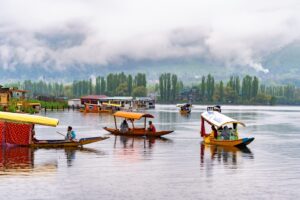India, known for its cultural diversity and rich heritage, is equally celebrated for its remarkable biodiversity. The country is home to over 100 national parks and 500 wildlife sanctuaries, offering travelers and nature enthusiasts an unmatched opportunity to witness rare flora and fauna in their natural habitat. Whether it’s spotting the majestic tiger in the dense forests of Madhya Pradesh or observing elephants in Kerala’s misty hills, wildlife sanctuaries & national parks in India promise thrilling experiences for all.
This article delves into the most iconic protected areas across the country, along with travel tips and insights to help you plan your perfect wildlife escape.
Why Visit Wildlife Sanctuaries & National Parks in India?
- Biodiversity Hotspot: India harbors species ranging from the Bengal tiger, Asiatic lion, and Indian elephant to snow leopards, red pandas, and one-horned rhinoceroses.
- Eco-Tourism & Conservation: These areas help promote sustainable travel and environmental awareness.
- Adventure & Photography: Jungle safaris, birdwatching, and nature trails provide perfect opportunities for adventure and wildlife photography.
Top National Parks in India
1. Jim Corbett National Park (Uttarakhand)
- Established: 1936 (India’s first national park)
- Famous For: Bengal tigers, leopards, elephants, crocodiles
- Best Time to Visit: November to June
- Activities: Jeep safaris, nature walks, and birdwatching
2. Ranthambore National Park (Rajasthan)
- Famous For: Royal Bengal tigers and Ranthambore Fort
- Unique Feature: Tigers often seen during the day
- Activities: Wildlife safaris and photography tours
3. Kaziranga National Park (Assam)
- UNESCO Site
- Home To: Two-thirds of the world’s one-horned rhinoceroses
- Also Spot: Elephants, wild buffalo, swamp deer, and migratory birds
4. Gir National Park (Gujarat)
- Only Home Of: Asiatic lions in the wild
- Rich Ecosystem: Also houses leopards, hyenas, and antelopes
5. Sundarbans National Park (West Bengal)
- UNESCO World Heritage Site
- Famous For: Mangrove forests and Royal Bengal tigers
- Access: Mostly via boat safaris through tidal waterways
Top Wildlife Sanctuaries in India
1. Periyar Wildlife Sanctuary (Kerala)
- Famous For: Herds of elephants and scenic lake safaris
- Location: Thekkady, in the Western Ghats
2. Bharatpur Bird Sanctuary (Keoladeo Ghana, Rajasthan)
- UNESCO Site
- Ideal For: Bird lovers; over 370 species including migratory birds from Siberia
3. Chilika Wildlife Sanctuary (Odisha)
- Known For: Chilika Lake, the largest coastal lagoon in India
- Species: Flamingos, dolphins, and various waterfowl
4. Dachigam Wildlife Sanctuary (Jammu & Kashmir)
- Specialty: Hangul (Kashmiri stag), Himalayan black bear
- Backdrop: Stunning Himalayan landscapes
5. Bhadra Wildlife Sanctuary (Karnataka)
- Location: Western Ghats
- Species: Tigers, gaurs, leopards, elephants
Wildlife Tourism Activities
- Jeep Safaris: Most popular way to explore national parks like Bandhavgarh, Kanha, and Tadoba.
- Elephant Safaris: Unique experiences offered in places like Kaziranga and Periyar.
- Boat Safaris: Ideal for spotting aquatic wildlife and birds, especially in Sundarbans and Periyar.
- Nature Walks: Available in sanctuaries with low predator density.
- Birdwatching: Especially rewarding in sanctuaries like Bharatpur, Chilika, and Ranganathittu (Karnataka).
Best Time to Visit Wildlife Sanctuaries & National Parks
- Winter (Oct–Feb): Best time overall; animals are more active and temperatures are pleasant.
- Summer (Mar–June): Good for tiger sightings, especially near waterholes.
- Monsoon (July–Sept): Many parks remain closed, but some southern sanctuaries stay open for lush greenery and birdlife.
Tips for Visiting Wildlife Sanctuaries & National Parks
- Book Early: Safaris and lodges in popular parks get booked months in advance.
- Respect Nature: No loud noises, feeding animals, or littering.
- Carry Essentials: Binoculars, cameras, hats, sunscreen, and insect repellent.
- Choose the Right Guide: A knowledgeable guide enhances your experience with facts and spotting tips.
- Wear Earth-Toned Clothing: Helps blend into the environment and avoids startling animals.
Eco-Friendly Wildlife Tourism
- Stay in Eco-Lodges: Many sanctuaries offer accommodations that follow sustainable practices.
- Support Local Communities: Buy local handicrafts and hire community-trained guides.
- Minimize Plastic Usage: Avoid single-use plastics to protect natural habitats.
Wildlife Tourism Packages
Tour operators and state tourism boards offer various packages, which may include:
- Entry fees and safari permits
- Guided tours with naturalists
- Accommodation in jungle resorts
- All meals and local transportation
- Optional add-ons: birdwatching tours, night safaris, village visits
Conclusion
India’s wildlife sanctuaries & national parks are more than just tourist destinations—they are crucial ecosystems that showcase the rich biodiversity of the subcontinent. Whether you’re watching a tiger emerge from the undergrowth in Bandhavgarh, listening to bird calls in Bharatpur, or drifting through the mangroves of Sundarbans, every experience leaves you spellbound.
India, known for its cultural diversity and rich heritage, is equally celebrated for its remarkable biodiversity. The country is home to over 100 national parks and 500 wildlife sanctuaries, offering travelers and nature enthusiasts an unmatched opportunity to witness rare flora and fauna in their natural habitat. Whether it’s spotting the majestic tiger in the dense forests of Madhya Pradesh or observing elephants in Kerala’s misty hills, wildlife sanctuaries & national parks in India promise thrilling experiences for all.
For nature lovers, photographers, and adventure seekers, these protected areas offer unmatched thrills and insights into the wild. So, the next time you’re planning a vacation, skip the cities and step into the wilderness—India’s natural wonders are calling.




